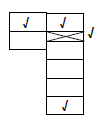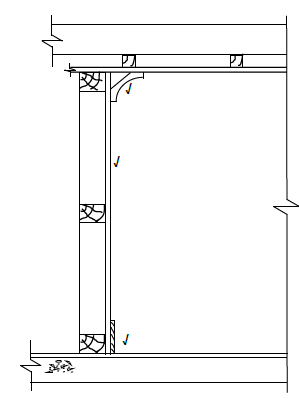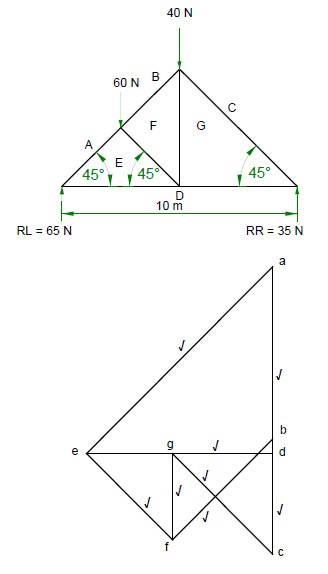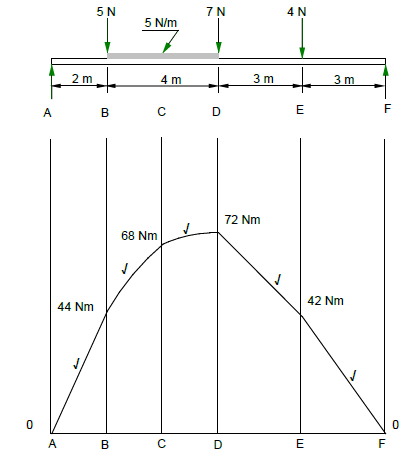CIVIL TECHNOLOGY GRADE 12 MEMORANDUM - NSC PAST PAPERS AND MEMOS NOVEMBER 2017
Share via Whatsapp Join our WhatsApp Group Join our Telegram GroupCIVIL TECHNOLOGY
GRADE 12
NOVEMBER 2017
MEMORANDUM
NATIONAL SENIOR CERTIFICATE
QUESTION 1: CONSTRUCTION, SAFETY AND MATERIALS
1.1
- Never use unsafe supports such as step ladders, drums, loose bricks, or crates on the scaffolding. √
- The worker should have worn a safety harness/safety rope/. √
- The worker should ensure that there are sufficient guard rails on the scaffolding.
- Always wear protective clothing when working on scaffolding/non slip safety footwear.
- The worker should ensure that the area is free of liquids and obstacles.
ANY TWO OF THE ABOVE (2)
1.2
- To prevent electric shock. √
- To keep the power tools in a working condition.
- To ensure the safety of the user.
- Live exposed wires can cause electrocution or fire.
ANY ONE OF THE ABOVE (1)
1.3
- The worker can be injured by the moving blade. √
- Measuring tools/tools may be damaged when touching the moving blade.
- Moving parts of the machine can be damaged
ANY ONE OF THE ABOVE (1)
1.4
- Tamping rod/rod √
- Cone/frustum/mould √
- Base plate/waterproof base √
- Folding ruler, tape measure, steel ruler/level/straight edge
- Shovel
ANY THREE OF THE ABOVE (3)
1.5
- Concrete mixer/machine mixed √
- Ready mixed concrete
ANY ONE OF THE ABOVE (1)
1.6
1.6.1 B √ (1)
1.6.2 C √ (1)
1.6.3 D √ (1)
1.6.4 F/M √ (1)
1.6.5 G √ (1)
1.6.6 J √ (1)
1.6.7 L √ (1)
1.6.8 I √ (1)
1.6.9 H √ (1)
1.6.10 A √ (1)
1.7
1.7.1  (4)
(4)
1.7.2 PLAN COURSE OF A QUOIN IN ENGLISH BOND/ CORNER BUILT IN ENGLISH BOND √
| ASSESSMENT CRITERIA | MARK | CANDIDATE’S MARK |
| Stretcher course | 1 | |
| Corner brick | 1 | |
| Queen closer | 1 | |
| Header course | 1 | |
| TOTAL | 4 |
(1)
1.7.3
- The queen closer creates the bond in the wall/quarter lap. √
- The queen closer closes the gap in the wall in the header course.
- The queen closer prevents a straight vertical mortar joint.
ANY ONE OF THE ABOVE (1)
1.8
| ASSESSMENT CRITERIA | MARK | CANDIDATE’S MARK |
| Supporting walls | 1 | |
| Roof | 1 | |
| TOTAL | 2 |
1.9
1.9.1
- A brush/sponge can be used to apply paint to a ceiling. √
- A roller can be used to apply paint to a ceiling.
- A spray gun/spray-painting equipment can be used to apply paint to a ceiling.
- A sponge can be used to apply paint to a ceiling.
ANY ONE OF THE ABOVE (1)
1.9.2
- Painting it with a brush will avoid fine paint spray on the walls and the floors. √
- Using a roller will be quicker than using a brush/prevent stripes.
- Spray painting will be quicker that painting with a brush and a roller.
A sponge can be used for the decorative application of paint. - ANY ONE OF THE ABOVE OR ANY OTHER ACCEPTABLE ANSWER (1)
1.10
1.10.1 Skirting/tile skirting √ (1)
1.10.2 Cornice √
ANY SUITABLE MATERIAL INDICATED FOR THE MANUFACTURING OF THE ABOVE COMPONENTS WILL BE ACCEPTED. (1)
[30]
QUESTION 2: ADVANCED CONSTRUCTION AND EQUIPMENT
2.1
2.1.1 D √ (1)
2.1.2 B √ (1)
2.1.3 B √ (1)
2.1.4 D √ (1)
2.1.5 C √ (1)
2.2
2.2.1 Dumpy level/surveying instrument/levelling instrument √ (1)
2.2.2
- To measure vertical and horizontal heights/levels √
- To measure vertical and horizontal angles
- To measure distances
- It is used for surveying/setting out of buildings.
ANY ONE OF THE ABOVE (1)
2.2.3 Tripod/baseplate √ (1)
2.2.4 Telescopic staff/levelling rod √ (1)
2.2.5
- To prevent it from getting damaged and wet. √
- To protect the instrument against dust/moisture/bumps/sun
- It is fragile.
ANY ONE OF THE ABOVE (1)
2.3
2.3.1 Rib and block concrete √ (1)
2.3.2
- – Concrete floor slab/concrete/slab. √
- – Concrete hollow block/rib block/block √
- – Reinforced steel mesh/reinforcement bars/bars √ (3)
2.3.3
- The rib and block method can be used anywhere, even in water. √
- Components are precast, thus it saves a lot of building time.
- Placing is relatively quick.
- Provides excellent resistance against soil movement.
- Work can proceed, despite the weather conditions.
- Plastering the underside of the floor can take place without any delays.
- No extensive formwork or shuttering is necessary.
- It is approximately 30% lighter than in situ floor slabs.
- No skilled labour is required as the supply company also does the installation.
- It is cheaper.
- Less quantity of material is used.
ANY ONE OF THE ABOVE (1)
2.4
2.4.1
- - Wall tie √
- - Damp proof course/DPC √ (2)
2.4.2
- Under the window sill √
- Under floor slab/Between the sub- and super structure
- At the base of external and internal walls
- Vertically at jambs or door frames
- Roof/parapet wall
- Above the lintel of a cavity wall
ANY ONE OF THE ABOVE (1)
2.4.3 The cavity in the walls are to:
- prevent rain water from penetrating the inner skin of the wall. √
- provide high insulation against heat, cold and sound.
- enable the use of cheaper or alternative materials for inner skin of the wall.
ANY ONE OF THE ABOVE (1)
2.5 Intrados – Is the inner surface of arches √
Extrados – Is the outer surface of arches √ (2)
2.6
2.6.1 Cube/Cube mould/Mould √
ANY ONE OF THE ABOVE (1)
2.6.2 Tamping rod/Rod/Trowel/Shovel √
ANY ONE OF THE ABOVE (1)
2.6.3 Cube test √ (1)
2.6.4
- The test is done to determine the compressive strength/crushing strength of concrete. √
- Test the strength of concrete.
ANY ONE OF THE ABOVE (1)
2.7 (2)
(2)
| ASSESSMENT CRITERIA | MARK | CANDIDATES MARK |
| Shear bar correctly drawn | 1 | |
| Stirrups correctly drawn and spaced | 1 | |
| TOTAL | 2 |
2.8
2.8.1 Twisted ribbed bar √
2.8.2 Ribbed bar √ (2)
2.9
2.9.1
- Wooden planks/timber √
- Block board
- Laminated board
- Shutter board
- Plywood boards
- Metal shutter
ANY ONE OF THE ABOVE (1)
2.9.2
B – Wedges √
C –Yoke √
D – Clamp/Cleat √
E – Threaded rod/bolt and nut/bolt √ (4)
2.9.3
- The yokes will not be tightened/Yokes will not be able to be joined. √
- The formwork will not be kept in place/collapse.
- The formwork will not be square.
- The yokes will not be in place.
- The formwork will not be rigid.
- Concrete will escape from the corners of the formwork.
ANY ONE OF THE ABOVE (1)
2.10
- There is insufficient soundproofing √
- There is less insulation against cold and heat
- It cannot be use externally
- The dry wall can easily be damaged/burnt
- The dry wall cannot carry heavy loads
ANY ONE OF THE ABOVE (1)
2.11 (3)
(3)
| ASSESSMENT CRITERIA | MARK | CANDIDATES MARK |
| Cladding correctly drawn | 1 | |
| Cornice/moulding at ceiling correctly drawn | 1 | |
| Skirting/quadrant at floor correctly drawn | 1 | |
| TOTAL | 3 |
2.12
- Preformed concrete piles √
- Steel tube caisson piles
- Driven in-situ piles
- Short bored piles
ANY ONE OF THE ABOVE (1)
[40]
QUESTION 3: CIVIL SERVICES
3.1
3.1.1 S – trap √ (1)
3.1.2 To prevent sewer-gas (foul air) from the sewerage system to enter the building. √ (1)
3.2
- The season/Cloud cover/weather conditions √
- Time of day √
- Duration of sunshine
- Cleanliness of glass panel
- Shadows over glass panels
- The intensity of direct sunlight
- The position/orientation of the panel to north
- Pitch of the panel
- The type of solar heater/panel
ANY TWO OF THE ABOVE (2)
3.3
3.3.1 Heating element/Element √ (1)
3.3.2
- The cold water inlet is placed at the bottom of the geyser so that the incoming cold water does not mix with the hot water/incoming cold water heated by the element. √
- The hot water outlet is placed at the top to discharge hot water which is concentrated at the top of the geyser. √
OR ANY OTHER ACCEPTABLE ANSWER (2)
3.3.3 Temperature and pressure safety valve/Safety valve/Pressure valve √ (1)
3.4
3.4.1
- The grid receives/drains storm water/allow storm water to enter storm water system/pipe. √
- Water is guided to flow off our roads on to the road kerbs and then into the road channel into the storm water pipes.
- Prevent waste like paper and plastic bags to block the storm water pipes.
- For safety purposes
ANY ONE OF THE ABOVE OR ANY OTHER ACCEPTABLE ANSWER (1)
3.4.2
- Roads will overflow with storm water. √
- Damage to the roads may be possible because of the storm water.
- Storm water will not be able to enter the grid.
- Storm water will flood surrounding areas
ANY ONE OF THE ABOVE OR ANY OTHER ACCEPTABLE ANSWER (1)
3.5
- Wind pump √
- Submersible water pump √
- Water pump
- Manual hand pump/hand pump
- Electric pump
- Solar powered pump
ANY TWO OF THE ABOVE (2)
3.6  (8)
(8)
| ASSESSMENT CRITERIA | MARK | CANDIDATES MARK |
| Fluorescent light | 2 | |
| Distribution board | 2 | |
| Double-pole light switch (one-way) | 2 | |
| Electric wiring | 2 | |
| TOTAL | 8 |
DRAWING SYMBOLS IN TEXTBOOKS FOR ABOVE ITEMS WILL ALSO BE ACCEPTED
3.7 (10)
(10)
| ASSESSMENT CRITERIA | MARK | CANDIDATE’S MARK |
| Rodding eye | 1 | |
| Gully | 1 | |
| Ventilation pipe/Vent pipe | 1 | |
| Branch pipes 45° | 2 | |
| Inspection eyes | 2 | |
| Any THREE abbreviations | 3 | |
| TOTAL | 10 |
[30]
QUESTION 4 QUANTITIES AND CALCULATIONS AND JOINING
4.1
4.1.1 Chipboard/drywall/counter sunk head screw/pozi drive screw √
Use:
Joining fabricated boards/machine made boards/board products/timber √ (2)
4.1.2 Steel cut nail/masonry nail √
Use:
Mainly used to fix skirting and cleats to brickwork √
OR
Oval nail
Use:
Used at edge of timber to prevent the timber from splitting
OR
Floor nail
Use:
Used to secure floor planks (2)
4.1.3 Sleeve anchor/Rawlbolt √
Use:
Fixing objects into concrete and brickwork/to join truss hangers against a wall √ (2)
4.2 Wire nails/clamp/hurricane clamps √ (1)
4.3 Nails:
- Quicker to drive in than screws √
- Available in a variety of lengths, thicknesses and strengths √
- Various heads for invisible or decorative use
- Cheaper than screws
- Can be made of rust proof material (copper or stainless steel)
- Can be quickly removed
- Tough and resilient
- Can be straightened and reused
- Nails requires a less skilful worker
- Not as time consuming as when inserting screws.
- Application of nails is much faster than screws.
ANY TWO OF THE ABOVE (2)
4.4Copper pipe/polycop pipes/PVC pipes/Composite pipes √ (1)
4.5
4.5.1 38/38 mm √ (1)
4.5.2 3 √ (1)
4.5.3 3 374/3 374 mm √ (1)
4.5.4 3 600/3 600 mm √ (1)
4.5.5 9 600/9 600 mm √ (1)
4.5.6 3 600/3 600 mm √ (1)
4.5.7 17 250/17 250 mm √ (1)
4.6
| A | B | C | D |
| Inside measurement of: | |||
| Long walls = 7 000 mm – 2/220 mm √ | |||
| = 6 560 mm √ | |||
| Short walls = 4 000 mm – 2/220 mm √ | |||
| = 3 560 mm √ | |||
| (4) | |||
| 1/ | 6,56 | Inside area of the room is | |
| 3,56 √ | 23,35 m2 √ | ||
| (2) | |||
| Area of one ceiling board: | |||
| 1/ | 4,2 √ | One board is 4 200 mm x 1 200 mm | |
| 1,2 √ | 5,04 m2 √ | (3) | |
| Length of skirting: | |||
| = (6 560 + 3 560) x 2 √ | |||
| = 20 240 √ – 3 000 mm √ | |||
| = 17,24 m √ | |||
| OR | |||
| = 13 120 √ + 7 120 √ - 3 000 mm √ | |||
| = 17 240 mm | |||
| = 17,24 m √ | |||
| OR | |||
| = 6 560 + 6 560 √ + 3 560 + 3 560 √ - 3 000 mm √ | |||
| = 17 240 mm | |||
| = 17,24 m √ | |||
| (4) |
[30]
IF A CANDIDATE DID NOT USE THE ANSWER SHEET TWO MARKS MUST BE DEDUCTED FROM THE TOTAL
IF A CANDIDATE DID NOT CONVERT TO METRES THE CANDIDATE SHOULD NOT BE PENALISED BUT THE FINAL ANSWER MUST BE IN SQUARE METRES/METRES
IF THE CANDIDATE WROTE THE MEASUREMENTS IN THE WRONG COLUMN ONE MARK MUST BE DEDUCTED FROM THE TOTAL
QUESTION 5: APPLIED MECHANICS
5.1
5.1.1 (A1 x d) + (A2 x d)
Total area
√ √ √ √
= (3 600 mm² x 30 mm) + (675 mm² x 25 mm)
4 275 mm² √
√ √
= 108 000 mm³ + 16 875 mm³
4 275 mm²
= 124 875 √ mm³
4 275 mm²
= 29,21 √ mm √
OR
| Part | Area A (A) | X | AX |
| 1 | 3 600 mm² √ | 30 mm √ | 3 600 mm x 30 mm = 108 000 mm³ √ |
| 2 | 675 mm² √ | 25 mm √ | 675 mm x 25 mm = 16 875 mm³√ |
| Σ | 4 275 mm² √ | 124 875 mm³ |
X=ΣAx
ΣA
= 124 875 √ mm³
4 275 mm³
= 29,21 √ mm √
IF A CANDIDATE SWOP AREA 1 AND 2 AROUND DEDUCT 1 MARK (10)
5.2.1 (8)
(8)
5.2.2
| MEMBER | NATURE | MAGNITUDE |
| AE | Strut √ | 92 N √ |
| DG | Tie √ | 35 N √ |
(4)
Tolerance of 1 N to either side
NOT TO SCALE DUE TO ELECTRONIC TRANSFER.
USE A MASK TO MARK THIS QUESTION.
IF THE CANDIDATE WROTE THE MEASUREMENTS IN THE WRONG COLUMN ONE MARK MUST BE DEDUCTED FROM THE TOTAL
5.3
5.3.1 20 N/m √ (1)
5.3.2 8 m √ (1)
5.3.3 4 m √ (1)
5.3.4  (5)
(5)
If the lines between B and D are straight lines no marks may be awarded for these lines.
NOT TO SCALE DUE TO ELECTRONIC TRANSFER.
USE A MASK TO MARK THIS QUESTION.
BECAUSE DISTANCES BETWEEN AB, BC, ECT. MAY DIFFER ON THE ANSWER SHEETS OF THE PROVINCES.
[30]
ANSWER SHEET 6.1
| NO. | QUESTIONS | ANSWERS | MARKS |
| 1 | Name the title of the drawing | South Elevation √ | 1 |
| 2 | Identify number 1. | Ridge/Ridge capping/Ridging √ | 1 |
| 3 | Identify number 2 | Tile roof/Tile/Roof tile/Concrete tile/roof covering √ | 1 |
| 4 | Identify number 3 | Gutter | 1 |
| 5 | Identify number 4 | Downpipe √ | 1 |
| 6 | Identify number 5 | North point/North direction/True North √ | 1 |
| 7 | Identify number 6 | NGL/Natural ground level/Ground level √ | 1 |
| 8 | Identify number 7 | Window Sill √ | 1 |
| 9 | Name the type of roof on the eastern side of the house. | Gable √ | 1 |
| 10 | Name the type of roof on the western side of the house. | Hipped roof √ | 1 |
| 11 | Name the material that can be used for the fascia board? | Wood/Timber/Cement fibre/uPVC/Plastic/Galvanised sheet metal √ | 1 |
| 12 | On how many sides of the building will you find fascia boards? | 3 sides √ | 1 |
| 13 | Draw the top view (roofline) of the roof for the elevation indicated in FIGURE 6.1 in the column alongside . |  | 3 |
| TOTAL | 15 |

| ASSESSMENT CRITERIA | MARKS | LM |
| Correctness of drawing | 3 | |
| External wall | 1 | |
| Symbol for wall | 1 | |
| Plaster | 2 | |
| Wall plate | 1 | |
| Tie beam | 1 | |
| Rafters | 2 | |
| Strut | 1 | |
| Queen post | 1 | |
| King post | 1 | |
| Fascia board | 1 | |
| Hanger | 1 | |
| Bearer | 1 | |
| Fibre cement ceiling board | 1 | |
| Any THREE labels | 3 | |
| Print title | 1 | |
| Application of scale One or two incorrect = 3 Three or four incorrect = 2 More than five incorrect = 1 No measurement correct = 0 | 3 | |
| Total | 25 |
[40]